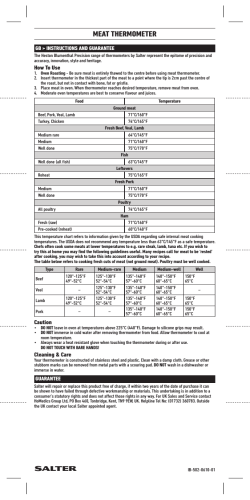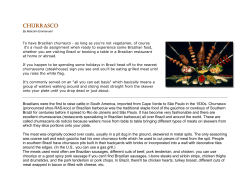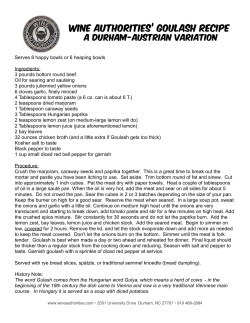
Tenderizering
Tenderizering Page 1 of 2 26 Lyerly St. Houston, TX 77022 713-691-2935 800-356-5189 Fax: 713-691-3250 Why is meat tough? Muscles have to endure a lot of mechanical stress; they are made of strong fibers that make them hard to cut, and tough connective tissue holds them together. Individual muscle cells contain microscopic fibrils that give them their structural integrity and allow them to contract. The fibrils have a complex internal structure bound together by long protein chains. The connective tissue that holds the muscle together is also mostly protein. There Are Several Methods To Tenderize Meat Natural - Most Meat Is Normally Required To Age For A Period Of Up To Three Weeks In Order For It To Be Commercially Acceptable For Human Consumption. Good Quality Meat Can Be Aged Longer If Desired. During The Aging Process, The Connective Tissues Of The Meat Are Broken Down By The Natural Enzymes Of The Meat, Thereby Improving The Tenderness And Edibility. Meat Can Be Dry Aged (Longer Time With Weight Loss) or Wet Aged (Shorter Time With No Weight Loss). Meat Is Kept Refrigerated During Aging and The Humidity is Controlled. Several methods are employed to reduce the aging period and to increase the degree of tenderness. One of these is the regulated application of heat, light, or both of these, to the meat, which speeds up the natural enzyme or bacteria action. In addition to reducing aging time, the meat industry in recent years has been seeking ways to increase the edible percent of the slaughtered animals, as well as to improve the edible quality of meat generally. Mechanical tenderization of the meat will assist in achieving these results. Mechanical tenderizers are machines/devices made in different styles - hand crank, push or electric. There are also attachments that fit on some electric meat grinders. All are designed to do one thing; tenderize meat by cutting muscle tissue. Mechanical tenderization is a method whereby fine incisions are made in the meat by closely spaced, specially designed knives, which cut the connective tissue. The mechanical tenderization process takes less than one minute with a roller type tenderizer or a crank type hand operated tenderizer. Meat, which has been treated in this manner, is immediately tenderized without the use of chemicals or other artificial means, or the need to wait for natural bacterial action to take place. The depth and the spacing of the knives and the number of times the meat is passed through the tenderizer permits the degree of tenderization to be determined, thus controlling the amount of tenderizing. Almost every grade of meat can be tenderized without danger of meat fabric deterioration or granulation. Meat, which has been mechanically tenderized, retains more of its natural appearance, shape, color, and weight. Manual tenderizers are made in two styles - Hammer & Push. Both are designed to do one thing; Tenderize meat by: Breaking / cutting muscle tissue of tough cuts of meat Punching holes (forking) in the meat to provide easier and quicker access for marinades and meat tenderizing enzymes used in the chemical method. Hammering the meat with a hammer type device breaks the meat's connective tissue and some meat fabric deterioration or granulation will occur. Push style units work like the mechanical units except the cutting knives are pushed into the meat when the user applies force to the handle. The push type that has blades will cut the connective thus tenderizing the meat. A push style with round prongs will provide access holes for the chemical tenderizers, which in turn tenderize the meat. For more recipes and information call us, come by or visit us on our Web Site. www.alliedkenco.com WE CATER TO THE “DO IT YOURSELF PERSON” CALL FOR A FREE SAUSAGE MAKING AND SUPPLIES CATALOG Tenderizering Page 2 of 2 26 Lyerly St. Houston, TX 77022 713-691-2935 800-356-5189 Fax: 713-691-3250 Vacuum Tumbling removes the air from a tumbling drum and rotate or tumble the product inside the drum. This creates a vacuum. This allows the meat pores to “open up” and accept the marinade & water. The tumbling action of a few minutes allows for a greater pickup up of water and spice - 10% - 20% compared to 1% - 2% when soaking for 48 hours. Chemical is the addition of meat tenderizing enzymes, which affect the connective tissue. This method is used to both flavor and tenderize meat. They are applied to meat by injection, rubbing, soaking or vacuum. When soaking meat always keep under refrigeration. A push style tenderizer with round prongs will provide access holes allowing these chemical tenderizers to quickly penetrate the meat thus speeding up the tenderizing process. This is called “forking” The two most often used meat-tenderizing enzymes are Papain and Bromelain. Both are derived from plant sources. These are the papaya fruit and the pineapple plant. Ficin, derived from fig tree latex, is also used. There are other sources of enzymes for meat tenderization but are not commonly used Often, the enzyme is included as part of a marinade which include various spices and flavor enhancers. For this method the marinade can be applied through the mechanical process called "forking", allowing the enzyme to penetrate the meat cut. Then, by cooking immediately a tenderized and highly palatable product is produced. Since these enzymes are deactivated by heat, (Papain 170-185 degrees F, Bromelain around 160 degrees F) they will continue to “tenderize” the meat until the meat is cooked. The heat will deactivate the enzyme. This is why meat tenderized using this method should be cooked and not stored. If stored and not cooked right away a mushy unpalatable texture will be present. In addition to beef, pork and chicken, these enzymes can also be used on seafood such as squid or clams. For more recipes and information call us, come by or visit us on our Web Site. www.alliedkenco.com WE CATER TO THE “DO IT YOURSELF PERSON” CALL FOR A FREE SAUSAGE MAKING AND SUPPLIES CATALOG
© Copyright 2025









